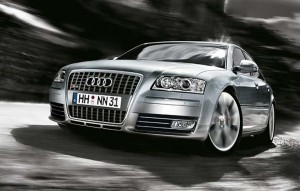You have your choice of good news or bad. When it comes to stolen cars, the good news is that the auto theft rate continues to decline, according to the National Highway Traffic Safety Administration.
The bad news? That might depend on what you own, especially if you park an Audi, Ford or BMW model in your driveway.
The top of the list is the Audi S8 which had a theft rate, according to NHTSA, of 8.81 per thousand in 2009 – the latest year for which data is available. But the fed report is based on percentages, not raw numbers. Audi only sold 227 of the S8s in the U.S. that year, and a grand total of 2 were stolen.
Using more conventional math reveals an entirely different picture, however, with more mainstream models like the Toyota Corolla, at the top of the list.
But on that percentage basis, the Ford Mustang Shelby GT screeched into second place on the chart, with a theft rate of 8.61 per thousand – meaning five of the 581 made were heisted.
In fact, the same pattern holds true for just about all the Top Five vehicles on the NHTSA theft list, the BMW M5 coming in third, with a theft rate of 7.58. The somewhat more mundane but still sporty Dodge Charger was fourth, at 6.47 per thousand, with the Honda S2000 rolling into fifth, at 5.60.
The rest of the Top 10, in order, were the Mitsubishi Galant, Chrysler 300, Infiniti M35/45, Cadillac STS and Mercedes-Benz CL.
If you were to look at raw numbers, rather than percentages, the picture is significantly different, and the year’s best-selling passenger car, the Toyota Corolla, also was stolen most often.
The news is not entirely bleak. NHTSA credits a variety of factors, including increased enforcement efforts, with a steady reduction in vehicle theft – which is now at its lowest level since 1967. Using data from 23,000 law enforcement and other organizations, the federal report says that an average 1.33 vehicles were stolen per 1,000 on the road in 2009. That was a 21.3% decline from 1.69 per thousand the year before.
The data show that the car theft problem has actually been brought under even more control than those numbers might suggest in most parts of the country. But there is still a significant problem in key parts of the U.S., notably in West Coast hot spots including Fresno, Sacramento, Spokane and Sa Francisco – Oakland.

